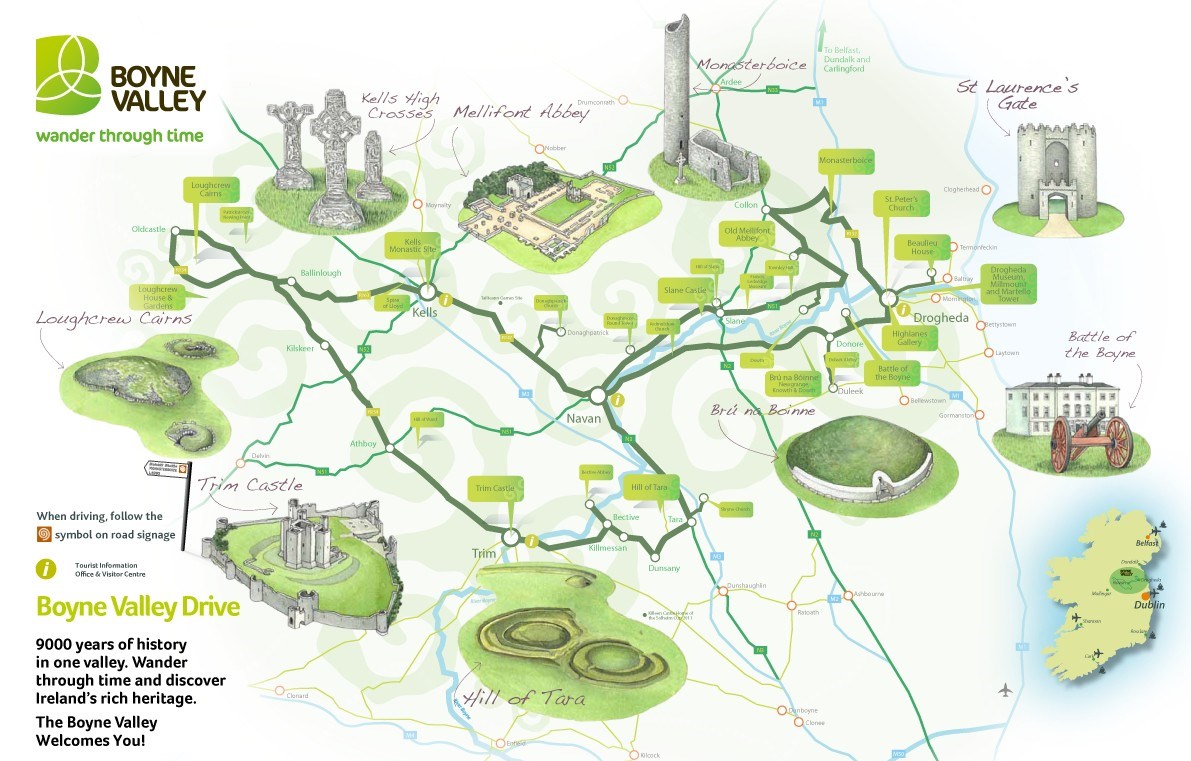



The Boyne Valley in the counties of Meath and Louth contains some of Ireland’s most historic visitor attractions. It is very easy to get around the Boyne Valley by car and there are plenty of activities and sites to see to keep all of the family amused! Here is a short summary of some of our favourites;
The Brú na Bóinne visitor centre is where you can gain access to the passage tombs of Newgrange and Knowth. The centre itself contains informative interpretive displays and viewing areas.

Newgrange dates back to 3,200 B.C making it older than Stonehenge and even the ancient pyramids of Egypt! At dawn on December 21st each year a ray of sunlight enters the tomb and lights up the inside chamber. To gain access on this special day there is an annual draw. It’s free to enter with your ticket so make sure to put your entry in the box! Knowth can also be accessed from Brú na Bóinne. What is special about Knowth is that you can climb up on top of the tomb and see fantastic views of the Boyne Valley. The inside of Knowth is artificially lit and makes for an interesting snap shot!
Our advice is to make Brú na Bóinne the first stop on your Boyne Valley tour and allow plenty of time for your visit. The site gets extremely busy and you may have to wait some time before you can visit the tombs. Also if you have 15 people or more in your group, you need to pre-book well in advance. If you’ve booked your package with the Irish Tourism Group, we can make that booking for you.

If you are interested in Irish military history then a trip to the Battle of the Boyne Site is not to be missed! The Battle of the Boyne on the 1st of July 1690 was one of the most significant military events in Ireland’s history. King William the 3rd’s victory at the Battle of the Boyne was the turning point in James the 2nd’s unsuccessful attempt to regain the Crown and ultimately ensured the continuation of Protestant supremacy in Ireland. The visitor centre and museum give a good overview of the events of the battle and its lead up and if you happen to visit on a Sunday (11am to 4.45pm in June, July & August) you can witness some very interesting re-enactments!

Trim castle is the largest and best preserved Anglo Norman castle in Ireland. Over hundreds of years Trim was adapted to suit the occupant’s needs and changing political climate however the main fabric of the building hasn’t changed much since Anglo-Norman times. Access to the castle is by guided tour only, the tour is wonderful but we recommend taking the tour only if you are not afraid of heights! There are quite a few steps to climb to get to the top but when you do, the views are spectacular!
Just down the road from the castle you can easily find Trim living history museum. Here a group of dedicated volunteers take you through the history of the town from life in Anglo Norman times to the making of the film Braveheart! Here you may be able to try on a suit of armour, feel the weight of a sword or practice your mace swing!

St. Peter’s Church one of the finest Gothic Revival Churches in Ireland and is most famous for housing the shrine of St. Oliver Plunkett. Plunkett was born in County Meath and was appointed Archbishop of Armagh and Primate of All-Ireland in 1669. He was arrested in 1679 on false charges of plotting to bring a French Army into the country, and of organising Irishmen to have rebellion. His remains were recovered and given to the Sienna Nuns of the Dominican Convent at Drogheda and here they remained. Thousands of people come to visit the church each year, if you visit yourself, please be quite and respectful as this church is still in use.

You can do a self-guided visit of Old Mellifont Abbey yourself but we recommend that you join a guided tour which can be arranged at no additional charge (May-September) at the museum reception. Your guide will take you through the various histories of the site from its origins as Ireland’s first Cistercian monastery, through to the period that it was owned and lived in by the Moore Family. During this time, the building played a pivotal role being the location where the Treaty of Mellifont was signed. This treaty changed the course of Ireland’s history by laying the foundations for the division of Ireland’s Northern counties from the South.
Get in Touch-
The best way to learn about Ireland is to visit yourself. Contact us today for a quotation today –
USA & Canada1877 298 7205
UK FreeFone0800 096 9438
International+353 69 77686
http://www.irishtourism.com/